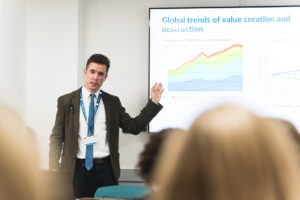
| Date | Author |
|---|---|
| 11th August 2020 | Nathalie Mortimer |
In recent months, universities have been feeling the pressure to recruit and retain students more than ever. Here, SUMS Associate Consultant Nathalie Mortimer explores what changes can be implemented, to increase engagement and conversion throughout the prospective student journey. Some insightful success stories are pointing towards the practical advantages of a customer experience centred approach.
“Whether or not they are ready for it, marketers should welcome the uncertainty of our current situation and look for new opportunity to leapfrog what was the norm. This does not mean scrapping everything that exists but rather employ an evolution of agility, consumer obsession and innovation. In this way marketers can be more prepared to weather the phases of recover, renew.”
Gartner, 2020
All universities are invested in their efforts to positively impact on the bottom line. Good Customer Experience (CX) is proven to do this. Gartner reports a 25% increase in web and mobile conversion, leading to direct income lift as a result of personalisation.
Specifically within Higher Education, Western Sydney University reported an 11% year on year increase in student retention in the enrolment funnel and Charles Sturt University reported a 346% increase in conversions through personalised experience following their implementation of Adobe Experience Manager.
We know that good customer experience requires a deep understanding of your audience and this in turn will enable you to design good customer journeys time and time again.
So what does good Customer Experience look like?
The expectations of Gen Z and Gen Alpha are changing and you need to ensure that you’re keeping abreast of these macro behavioural, attitude and expectation changes.
Ensure that data and insight are at the heart of your offer – we mean this in terms of your course portfolio development, your student experience, your prospective student engagement and of course your customer journeys across all audiences – the stories found in your data will provide insight into many things: subject trends, satisfaction with interactions, behavioural trends amongst your prospective students, internal efficiency benchmarks and much more.
Deliver an omnichannel customer experience, this means meeting your prospective students where they are, consider the entire user experience from their point of view.
Generally speaking, your audience would rather solve issues on their own than reach out to engage with you. You can help them help themselves with data-driven content and by implementing a fresh approach to content design.
Tailoring your offer, communications and engagement towards student personas can go a long way as it increases the chances of your content and communications resonating with your target audience, gives them a greater sense of ‘reason to believe’ and ‘reason to belong’ and is proven to increase conversion.
Last but not least is the need to demonstrate empathy, this links closely with personalisation. The more data and insight you glean and more importantly use to personalise the student experience enables you to demonstrate more thoughtful and efficient responses to better meet their needs.
Ultimately, you need to apply the key principles of consumer-centricity and have the right technology in place to do the heavy lifting in terms of data, analytics, machine learning, AI and so on. This will enable you to undertake trends analysis, personalise and customise your journeys, glean ongoing insight and be able to analyse what is and isn’t working to maximise your marketing strategies.
It’s widely accepted that the UK HE sector is behind the curve in being able to deliver all of this currently – CX is often designed around internal workflows and organisational structure rather than actual journeys.
There are always ways to enhance your current approach, even without the need to invest in technology – from user journey mapping, internal workflow and process reviews to organisational design reviews and implementing a new approach to content design. Student journeys are far from linear and they don’t fit the neat boxes that the sector often applies to them. At SUMS, we recognise the need to be multifaceted rather than homogeneous and in our experience, you can undertake reviews and implement new student journeys swiftly with the right level of focus.
To get this right, you need to consider people, process and systems, but this does not mean it has to be a long-drawn-out review. Rapid improvement is entirely feasible for example; event enhancements, improved personalisation, reducing the number of handoffs in the process and starting to establish a data-driven operating model, to name just a few.
However, in the year 2020, CMOs really need to consider the technology infrastructure that’s available to support their teams. People and technology are innately co-dependent and to enable a customer-centric culture, one where real-time insight is available at your fingertips, your teams will need the right tech in place to help them to achieve this.
In addition to Adobe Experience Manager for the automation of content creation, Microsoft’s vast stack of technologies can support with the quick wins you may need to start your transformation journey.
Within the same suite as Microsoft’s enterprise business applications, Dynamics 365, the Power Platform gives you the tools to expand and extend the functionality that exists across your existing technology estate. For example, with Power Apps, you can build pixel perfect mobile applications to interface with less user-friendly systems that you currently have in place. Similarly, Power Automate can accelerate your integration between legacy applications with its low-code RPA functionality.
While not strictly in a student recruitment setting, Staffordshire University and the University of New South Wales have seen successes by leveraging the power of their rich Microsoft ecosystem with exceptional engagement outcomes. The common theme between these two projects is the concept of an MVP delivered following an agile methodology. To encourage a true culture of transformation, HEIs need to move away from long, expensive waterfall IT projects and be comfortable in releasing solutions that may not be the perfect version that will be in place eventually.
Webinar Recordings:
View the full video recording for webinar 1, Cutting through the COVID noise: the need for transformation today, here.
View the full video recording for webinar 2, Proposed solutions: the quick wins, here.
View the full video recording for webinar 3, Playing the long-game: learning from the quick wins for the long-term solution here.








